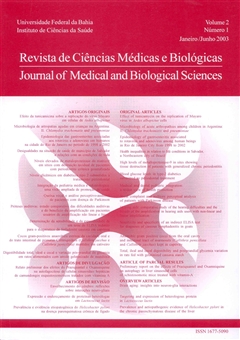Anaerobic gram positive cocci from the oral cavity and intestinal tract of marmosets (Callithrix penicillata and Callithrix jacchus) kept in captivity
DOI:
https://doi.org/10.9771/cmbio.v2i1.4257Keywords:
Marmosets, Anaerobic Gram positive cocci, Isolation, Streptococcus, Peptostreptococcus.Abstract
The present work describes the recovery and identification of anaerobic Gram positive cocci of the oral cavity and fecal specimens of Marmosets bred in captivity in the Central Bioterium of the ICB/UFMG. Fecal and oral specimens were collected from 8 animals, cultivated in blood agar medium with neomycine and Thioglicolate supplemented broth. The isolated strains were identified according to microscopic appearance, colonial morphology, respiratory characteristics and biochemical tests. Anaerobic Gram positive cocci were recovered from oral and fecal specimens of marmosets; a greater recovery was obtained from the oral cavity. Streptococcus intermedius, Streptococcus parvulus, Peptostreptococcus prevotii and Streptococcus sp. were isolated from fecal specimens. Within the fecal specimens, Peptostreptococcus sp., Peptostreptococcus productus and Streptococcus parvulus were isolated. Those findings represent an original contribution to the knowledge of the marmosets’ oral intestinal microflora, especially to the Comparative Microbiology, by considering that that group is among the most frequent anaerobic microbes related to human infections.Downloads
Download data is not yet available.
Downloads
Published
2003-01-01
How to Cite
Moreira, A. C. A., Carvalho, M. A. R. de, Cisalpino, E. O., Damasceno, C. A., & Negrette, A. C. (2003). Anaerobic gram positive cocci from the oral cavity and intestinal tract of marmosets (Callithrix penicillata and Callithrix jacchus) kept in captivity. Journal of Medical and Biological Sciences, 2(1), 94–103. https://doi.org/10.9771/cmbio.v2i1.4257
Issue
Section
ORIGINAL ARTICLES
License
The Journal of Medical and Biological Sciences reserves all copyrights of published works, including translations, allowing, however, their subsequent reproduction as transcription, with proper citation of source, through the Creative Commons license. The periodical has free and free access.


